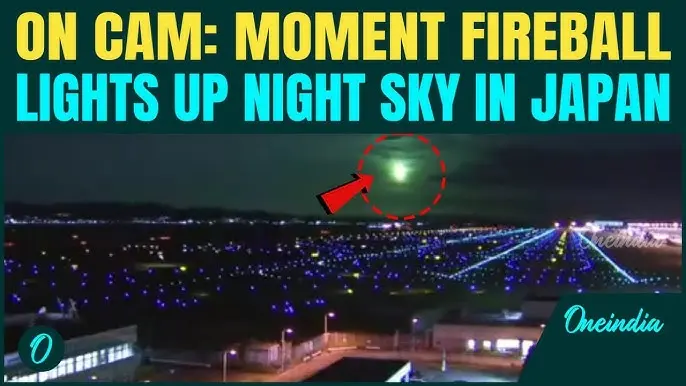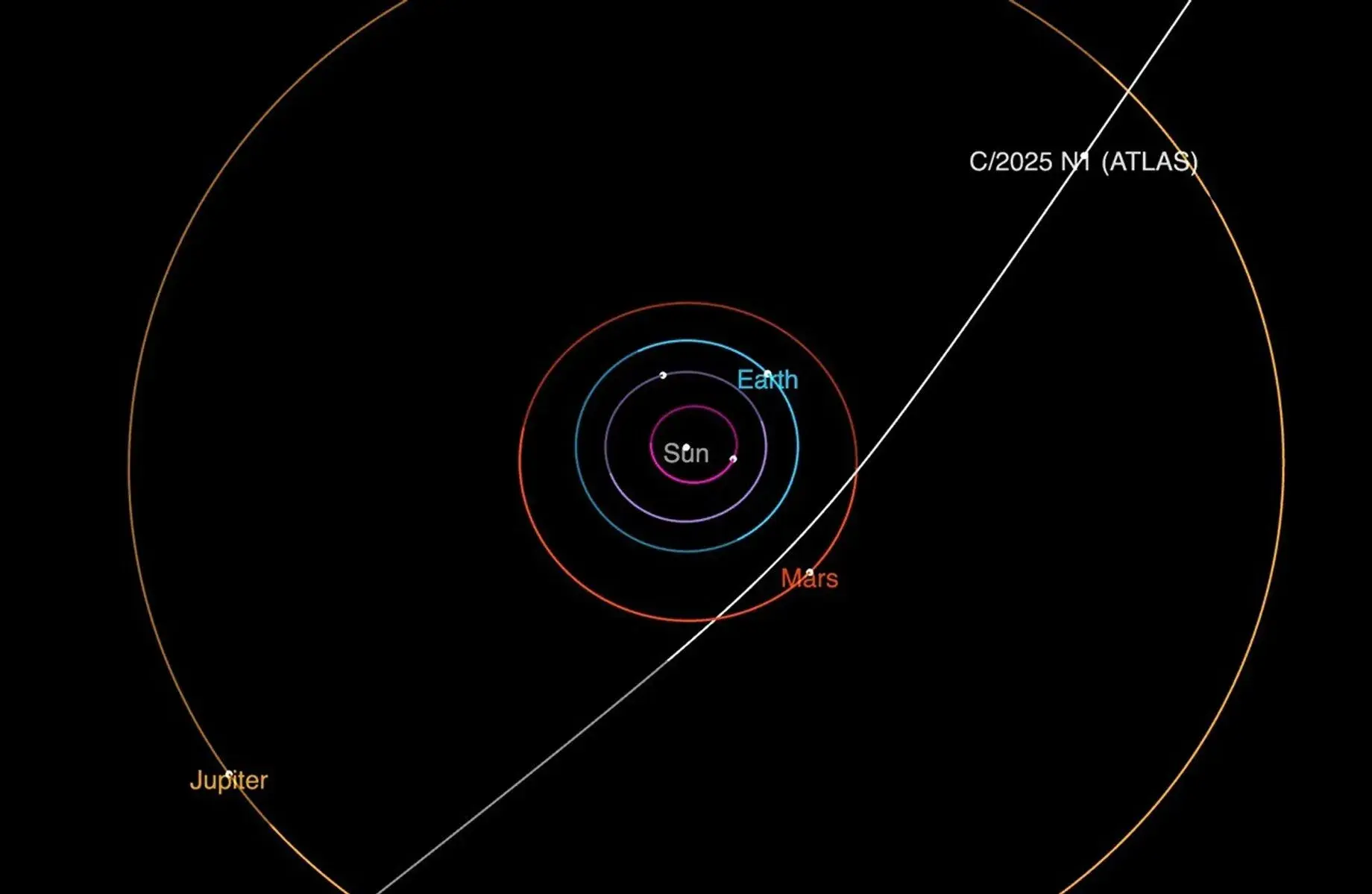Introduction
In recent weeks, a dramatic claim has gone viral: that a massive spacecraft, identified as 3I/ATLAS, has been sighted in Japan. According to social-media posts and fringe websites, what was originally described by astronomers as an interstellar comet may actually be an advanced alien vessel visiting Earth. In this article, we’ll dive deep: we’ll review the scientific facts about 3I/ATLAS, the origins of the “spaceship” narrative, the Japanese context of the sighting claim, and separate what we know from what we don’t. By the end, you’ll have a clear, informed understanding of the phenomenon and how to interpret it.
What is 3I/ATLAS?
Discovery and interstellar origin
The object 3I/ATLAS was discovered on 1 July 2025 by the Asteroid Terrestrial‑impact Last Alert System (ATLAS) survey. NASA Science+23iatlas.biz+2 It is designated “3I,” meaning it’s the third confirmed interstellar object to pass through our solar system — after 1I/ʻOumuamua (2017) and 2I/Borisov (2019). Wikipedia+1
Trajectory and physical characteristics
3I/ATLAS follows a hyperbolic orbit (unbound to the Sun), indicating it came from outside the solar system. NASA Science+1 It will pass its closest point to the Sun (perihelion) on about 29-30 October 2025, at roughly 1.4 au (astronomical units). NASA Science : The closest approach to Earth is about 1.8 au — so it does not pose any impact risk. NASA Science
Spectroscopic studies show that 3I/ATLAS has some unusual chemical composition: a coma dominated by carbon dioxide (CO₂) relative to water (H₂O) with a CO₂/H₂O ratio of ~8:1 — among the highest seen for a comet. arXiv+1
Why the “spaceship” speculation?
Because of its interstellar origin, unusual chemistry, and speed, some scientists and popular media outlets (including one from a Harvard University professor) have raised the possibility that it might not be a natural object, but rather a piece of alien technology. Live Science+1 Though, it is important to emphasize: the mainstream scientific consensus remains that 3I/ATLAS is a natural cometary body. Live Science

The Japan “spaceship sighting” claim
What has been claimed
In social-media posts and some news outlets, there are claims that a “large vessel” associated with 3I/ATLAS was filmed or imaged near Japan. One headline read: “3I/ATLAS leaked actual footage shows large vessel and NASA activated Planetary Defense Network for interstellar object”. The Economic Times . These suggest that Japanese observers captured the object, or that it is hovering near Earth / Japan.
Why Japan?
While the claims don’t clearly indicate where in Japan the sighting took place, it appears that Japanese astronomy forums and UFO-interest sites have circulated images or videos (often ambiguous or low-quality) purportedly showing the object. Some of these posts tie into a broader narrative of “first contact” or a “spaceship arrival” scenario tied to late 2025. 3iatlas.biz+1
Scientific evaluation of the sighting claim
There is no verified peer-reviewed report that an actual spacecraft was observed near Japan related to 3I/ATLAS.
The official data from NASA and other agencies treat 3I/ATLAS as a comet, not a spaceship. NASA Science+1
Many of the “footage” claims are unverified, lack metadata (date/time/location), and may derive from misidentified natural phenomena or hoaxes. The Economic Times
The trajectory of 3I/ATLAS and its distance mean it is not expected to come close to Earth, making direct sighting from ground-level highly unlikely at naked-eye visibility. NASA Science+1
What might the truth be?
Most plausible scenario: a natural interstellar comet
Given the current scientific observations, the most likely explanation remains that 3I/ATLAS is a natural interstellar comet:
Its hyperbolic orbit indicates solar-system escape velocity.
Its composition (CO₂-rich, dust, and ice coma) fits a comet, albeit an unusual one.
It is being tracked by professional telescopes and NASA/ESA facilities.
Alternate scenario: misinterpretation or hoax
The “spaceship in Japan” story may reflect one or more of the following:
Misidentification of ordinary aircraft, satellites, meteors, or atmospheric phenomena.
Viral social-media posts that leap from “interstellar object” to “alien ship” for attention.
Interpretations of ambiguous imagery (blurry lights in the sky) are then tied to 3I/ATLAS incorrectly.

Speculative scenario: something more exotic
A very small number of scientists (e.g., Prof. Avi Loeb) have posited that 3I/ATLAS could be an artificial object — perhaps a probe or vessel from an alien civilization. Live Science . If this were true, then the sighting claim in Japan would be extraordinary—but at present, there is no conclusive evidence to support that.
Why this matters
Scientific importance
3I/ATLAS gives astronomers a rare chance to study material from beyond our solar system — offering insights into how planetary systems form elsewhere. The unusual chemical signature (CO₂ dominance) may point to different formation conditions or environments. arXiv+1
Public interest and cultural impact
The narrative of “an alien ship seen over Japan” taps into longstanding human fascination with UFOs, extraterrestrial contact, and cosmic mysteries. Even if the claim is unverified, it illustrates how scientific findings can be transformed through social media into sensational stories.
Critical thinking opportunity
This situation is a strong reminder of how to approach extraordinary claims:
Check whether the claim is supported by peer-reviewed evidence or professional observatories.
Distinguish between what is measured (orbit, spectrum) and what is speculated (spaceship arrival).
Be mindful of viral imagery, lack of metadata, and alternative natural explanations.
What to look for in the coming months
| Item | Why it matters |
|---|---|
| Further observations of 3I/ATLAS’s coma composition | Could refine understanding of its origin and nature. |
| Official statements from NASA/ESA/JAXA | Would clarify whether any “spaceship” scenario has credence. |
| Independent verification of Japanese sighting imagery | It would help confirm or debunk the “spaceship sighting” claim. |
| Media coverage and scientific publications | Distinguish between sensational headlines and rigorous science. |
FAQs
Q1: Is 3I/ATLAS going to hit Earth?
A1: No. Its minimum distance to Earth is about 1.8 au (~270 million km), so it poses no collision threat. NASA Science
Q2: Could we see 3I/ATLAS with the naked eye over Japan?
A2: Unlikely. Scientific data suggest it will remain faint, and its path means it will not appear as a bright object in the night sky over Earth. Wikipedia
Q3: Is there credible proof that it’s an alien spaceship?
A3: No credible proof exists. The vast majority of scientists view it as a natural interstellar comet. Speculations of alien origin remain unverified. Live Science+1
Q4: Why did Japanese social-media posts link 3I/ATLAS to a spaceship sighting?
A4: Likely due to the combination of: interstellar origin (which invites sci-fi narratives), ambiguous sky imagery, and viral excitement. No professional observatory has confirmed such a sighting in Japan.
Q5: What makes 3I/ATLAS different from previous interstellar objects?
A5: It has an unusually high CO₂-to-H₂O ratio in its coma — about 8:1 — which is rare among comets. This suggests it may have formed in a different environment than typical solar-system comets. arXiv
Q6: When will we know more about this object?
A6: Observational campaigns are ongoing through late 2025 and possibly into early 2026. New data from telescopes like the James Webb Space Telescope, the Mars Reconnaissance Orbiter, and other platforms will refine our knowledge. NASA Science
Conclusion
The claim that a “spaceship” version of 3I/ATLAS has been seen in Japan is certainly intriguing — but at this point remains speculative and unconfirmed. On the stronger ground, what we do know is that 3I/ATLAS is a remarkable interstellar visitor, offering scientists a rare window into material from outside our solar system. While the idea of an alien ship hovering over Japan makes for exciting headlines, the most responsible view is cautious: treat such claims as possible but unverified, while supporting the scientific study of this object.